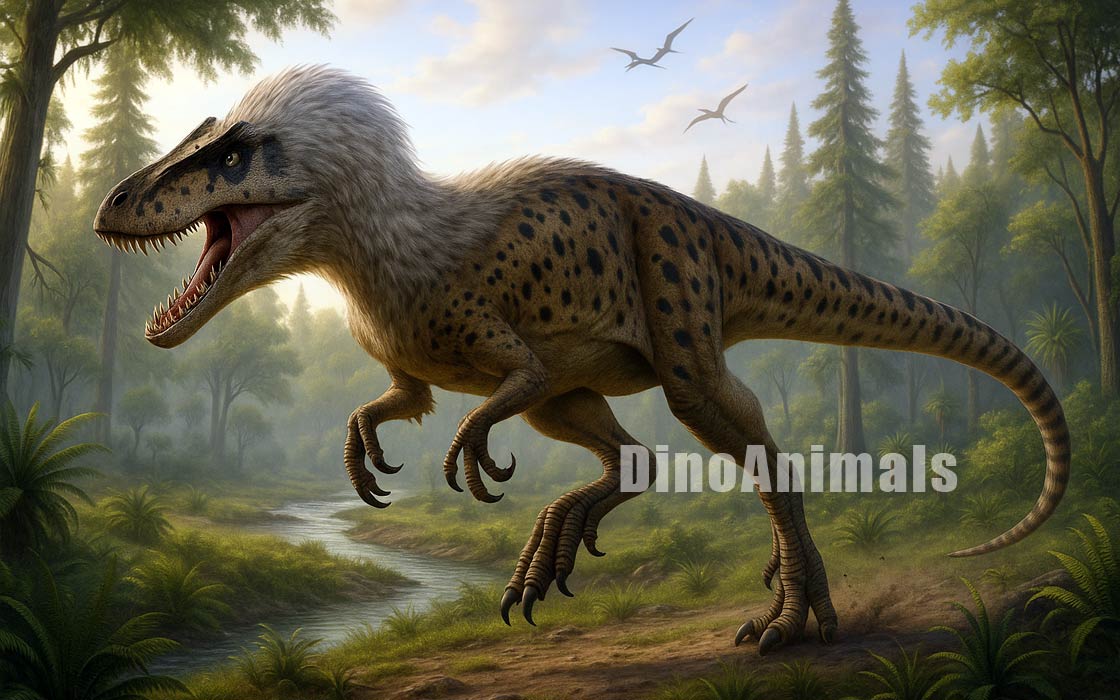Every month, 100,000 readers use the Dinosaur Database, but we receive no support from you. Developing and updating the database requires a lot of work. If you want it to remain open and be updated, please support us via the "Buy us a coffee" button available on every page or via the Support page.
Dinosaur: Nanotyrannus lethaeus

| Length*: | 7 m | 23.0 ft |
| Weight*: | 1.2 t | 2,646 lb |
*The largest known specimen
Period
Epoch: Late Cretaceous
Stage: Late Maastrichtian
Years: 72.1–66 Ma
Details
Status: valid
Author: Bakker, Williams & Currie
Year: 2025
Distribution
Area: North America
Country: USA
Region: Montana
Formation: Hell Creek, Lance
Description
Nanotyrannus lethaeus
Recent research published in 2025 by paleontologists Lindsay E. Zanno and James G. Napoli has introduced Nanotyrannus lethaeus as a new species within the genus Nanotyrannus, confirming the validity of Nanotyrannus as a distinct taxon separate from Tyrannosaurus rex. This study, based on the well-preserved “Jane” specimen (BMRP 2002.4.1) from the Hell Creek Formation in Montana, USA, along with comparative analyses, provides evidence from anatomy, histology, growth modeling, and phylogeny.
The findings distinguish N. lethaeus from N. lancensis (including CMNH 7541 and NCSM 40000) as a larger-bodied species, while reinforcing Nanotyrannus as an early diverging eutyrannosaurian outside Tyrannosauridae. This supplement expands the description of N. lethaeus, highlighting its unique features, growth patterns, ecological role, and distinctions from Tyrannosaurus rex. All measurements are given in metric units with imperial equivalents in parentheses for clarity.
Taxonomic History and Validation
Nanotyrannus lethaeus was newly described in 2025 as a second species in the genus Nanotyrannus, based on the specimen BMRP 2002.4.1, previously nicknamed “Jane.” Discovered in 2001 in Carter County, Montana, “Jane” was initially interpreted as either a juvenile Tyrannosaurus rex or Nanotyrannus lancensis. The 2025 study reassigns it to N. lethaeus due to distinct anatomical differences from N. lancensis (e.g., an open fossa in the palatine recess versus a discrete sinus) and lack of transitional features to T. rex.
The etymology derives from Latin “Lethaeus,” referring to the River Lethe in Greco-Roman mythology – a nod to the Hell Creek Formation and the specimen’s “reincarnation” from prior misidentifications. Phylogenetic analysis places Nanotyrannus (including N. lethaeus) in the new family Nanotyrannidae, as a basal eutyrannosaurian retaining primitive traits from mid-Cretaceous tyrannosauroids. Over 200 tyrannosaur fossils were reviewed, showing no intermediates between Nanotyrannus and T. rex, confirming coexistence and ecomorphological distinction in the Maastrichtian of North America.
Physical Appearance and Anatomy
Nanotyrannus lethaeus was a mid-sized theropod with a sleek, agile build, similar to N. lancensis but larger and with specific autapomorphies. As a eutyrannosaurian, it shares genus-level features like a narrow skull, unserrated chisel-shaped premaxillary teeth, and proportionally large forelimbs, but differs in details:
- Skull and Dentition: The skull is elongated and gracile, with a weak maxillary flange and an open fossa in the rostral palatine recess. The second mesialmost dentary tooth is unreduced (unlike in N. lancensis). Approximately 25 teeth per dentary side, with unserrated premaxillary crowns. A caudodorsal prong on the squamosal process of the postorbital and a rostral buttress on the jugal process of the palatine are autapomorphic.
- Axial Skeleton: The axis neural spine is distinctly crenulated throughout its length. Single pleurocoel on the axial centrum; caudal vertebrae are apneumatic (lacking pneumatic features seen in N. lancensis).
- Forelimbs and Pectoral Girdle: Forelimbs are robust and proportionally longer than in T. rex, with the humerus entepicondyle subvertical in distal view. Shares genus traits like a flattened humeral head and hypertrophied radial condyle.
- Hindlimbs and Pelvic Girdle: Hindlimbs are slender for agility, with asymmetrical extensor fossa on metatarsal III. The pubic boot has a strongly dorsally convex caudal margin – an autapomorphy distinguishing it from the straight margins in N. lancensis.
- Other Diagnostic Traits: Braincase and pneumatic features align with Nanotyrannus, including a downturned endocast and laterally oriented vagus canal. Differs from N. lancensis in lacking infraprezygapophyseal pneumatic recesses on proximal caudals and having a more convex pubic boot.
- Three fingers: Unlike its more derived relative Tyrannosaurus rex, which possessed reduced forelimbs with only two functional fingers (digits I and II), Nanotyrannus lethaeus retained a more primitive three-fingered manus (digits I, II, and III), as inferred from the genus-level diagnosis. This is evidenced by the presence of a discrete manual phalanx III-1 in related specimens, allowing for potentially greater dexterity in grasping or manipulating prey, though the holotype BMRP 2002.4.1 preserves only the left humerus and lacks direct manual elements.
Overall, N. lethaeus measured about 5.5-6.5 meters (18-21 feet) long and 1.8-2.2 meters (6-7 feet) tall at the hip, with a narrower snout and enhanced dexterity suited for pursuing agile prey.
Size, Growth, and Maturity
Bone histology from BMRP 2002.4.1 shows the individual was immature at death, with an estimated mass of 819 kg (1,807 lbs). Growth models project an asymptotic (adult) mass of 1,264 kg (2,787 lbs), larger than N. lancensis (around 700 kg or 1,543 lbs) but still over an order of magnitude smaller than T. rex (6,753-8,223 kg or 14,890-18,128 lbs). Maturity was reached in 15-20 years, similar to other non-tyrannosaurine tyrannosaurids, with a steady trajectory entering the asymptotic phase.
Modeling Nanotyrannus specimens as Tyrannosaurus juveniles yields implausible bimodal growth, supporting N. lethaeus as a distinct taxon.
Differences from Tyrannosaurus rex
Nanotyrannus lethaeus superficially resembles juvenile T. rex in slender proportions but exhibits invariant traits like more teeth (ca. 25 per dentary side vs. 13-14 in T. rex), unserrated premaxillary teeth, absence of postorbital cornual processes, and larger forelimbs (over twice proportional size). No ontogenetic shift to T. rex-like robustness; mature Nanotyrannus retain gracile features. Ecomorphologically, N. lethaeus was a swift hunter of medium prey, contrasting T. rex‘s bone-crushing apex role.
Paleoecology and Implications
Nanotyrannus. lethaeus inhabited the Hell Creek Formation’s floodplains in Carter County, Montana, dated to the middle/upper Maastrichtian (ca. 66.5-67 million years ago). It coexisted with T. rex, N. lancensis, Triceratops horridus, and Edmontosaurus annectens, occupying a niche as an agile predator. This indicates greater tyrannosauroid diversity near the end-Cretaceous extinction, challenging prior assumptions of T. rex dominance.
The revelation requires reevaluating studies on T. rex ontogeny and ecology. BMRP 2002.4.1 is under monographic study; future work may refine juvenile T. rex identifications
Locations
Sources
References: Woodward (2020). Growing up Tyrannosaurus rex: Osteohistology refutes the pygmy “Nanotyrannus” and supports ontogenetic niche partitioning in juvenile Tyrannosaurus. Zanno, Lindsay E.; Napoli, James G. (2025-10-30). "Nanotyrannus and Tyrannosaurus coexisted at the close of the Cretaceous"




